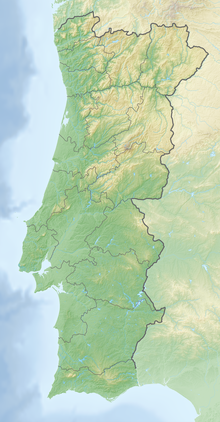Castro do Monte Padrao
Location of the Castro do Monte Padrão in Portugal. |
The Castro do Monte Padrão , also known as Castro do Monte Córdova , is a fortified hilltop settlement in northern Portugal that was founded in the Bronze Age and existed until the Middle Ages .
location
The heavily fortified settlement is located on the eponymous Monte Padrão at a height of 400 m. The Monte Padrão is part of a ridge running in north-south direction and juts out like a spur into the western plain. This prominent topographical location favors the defense of the settlement area on the one hand and allows control over the valley of the Sanguinhedo and the fertile plains of Refojos and Agrela in the south as well as over the basin of the Leça on the other .
Administratively, the site belongs to the municipality ( Freguesia ) Monte Córdova in the district ( Concelho ) Santo Tirso in the district of Porto .
history
The oldest finds and traces of settlement date from the late Bronze Age (9th century BC). The majority of the building finds can be attributed to the Iron Age and above all to the Roman era.
The remains of a church and graves are known from the high and late Middle Ages . The extent to which the more than 2000 year-old space continuity is also reflected in the settlement continuity cannot be assessed on the basis of the current state of research. Only the spatial distribution of Iron Age rotunda to later Roman villae suggests settlement continuity for these two epochs.
research
The Castro was first archaeologically examined by Carlos Faya Santarém in the 1950s, and since 1985 other smaller excavations have taken place on the site. In 1986 a Centro Interpretativo was opened not far from the site.
As early as 1910, the site was registered as a Monumento Nacional ; the protection status was supplemented in 2011 by the establishment of a Zona Especial de Protecção .
Findings
One of the three walls that protected the settlement is still visible today. The dry stone wall was erected in a box construction and the quarry filling was provided with a facing on the outside. Exact clues for the dating of the wall are not yet available, but due to the type of construction it can be associated with the Iron Age and Roman settlement of the square.
Several round buildings date from the Iron Age , which are typical for comparable settlements of the Castro culture at this time .
Two large buildings in the north-west of the plateau can certainly be dated to Roman times. The so-called "Domus" has a paved atrium with a portico to which several side rooms are attached. Not far to the west, another large rectangular building with numerous rooms was uncovered. Paved floors and several drainage channels were also found in this building. The finds from both buildings indicate a long-term use between the 1st and 4th century AD close.
The remains of the church of St. Rosendo and the adjoining medieval buildings probably date back to the 10th century. The associated cemetery was occupied until the 14th and 15th centuries. Thereafter, no evidence of further settlement on the mountain was found.
Finds
From the late Bronze Age, polished axes, flint blades , quartzite scrapers , bowls of the Alpiarça type and conical vessels have been found. Local ceramics as well as imported ceramics, amphorae , glasses, bricks, necklaces made of glass beads, small lamps, coins and fibulae date from the Iron Age and the Roman period. Slag residues indicate metal processing within the settlement. Some metal parts, including an enameled plate, as well as some coins and ceramic fragments, some of which have figurative or floral decorations, date from the Middle Ages .
literature
- Thomas G. Schattner (ed.): Archaeological guide through Portugal (= cultural history of the ancient world . Volume 74). Philipp von Zabern, Mainz 1998, ISBN 3-8053-2313-1 , p. 72.
- further reading under Patrimonio Cultural sv Bibliografia.
Individual evidence
- ↑ a b c d e f DGPC | Pesquisa Geral. Retrieved November 26, 2017 (Portuguese).
- ↑ a b c d e f Portal do Arqueólogo. Retrieved November 26, 2017 .
- ↑ a b c d Thomas G. Schattner (ed.): Archaeological guide through Portugal (= cultural history of the ancient world. Vol. 74). Philipp von Zabern, Mainz 1998, p. 70.
- ^ Centro Interpretativo do Monte Padrão . ( cm-stirso.pt [accessed November 26, 2017]).
Web links
Coordinates: 41 ° 18 ′ 45.7 " N , 8 ° 26 ′ 57.5" W.


